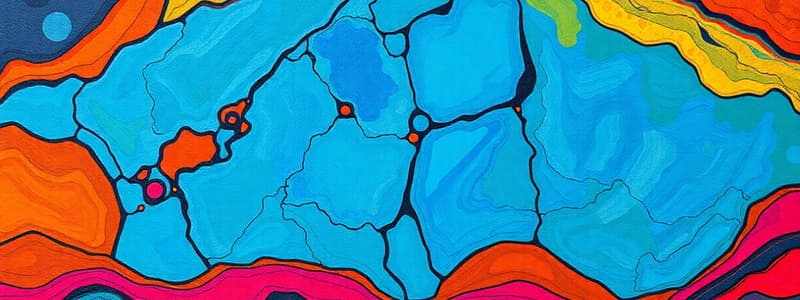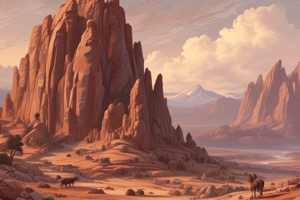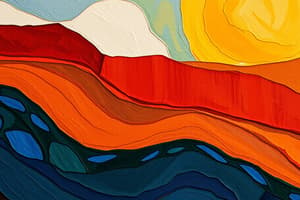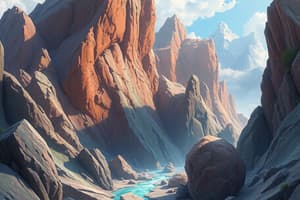Podcast
Questions and Answers
Which characteristic is LEAST reliable for differentiating igneous rocks from sedimentary rocks?
Which characteristic is LEAST reliable for differentiating igneous rocks from sedimentary rocks?
- Presence of sedimentary bedding.
- Presence of interlocking crystal patterns.
- Absence of fossils. (correct)
- Lack of rounded grains.
A geologist finds a rock sample with visible mineral crystals that appear randomly oriented. Which rock type is MOST likely?
A geologist finds a rock sample with visible mineral crystals that appear randomly oriented. Which rock type is MOST likely?
- Igneous rock with granitic texture. (correct)
- Foliated metamorphic rock.
- Sedimentary rock with clastic texture.
- Unfoliated metamorphic rock.
When classifying an igneous rock, which property is considered FIRST, according to the content?
When classifying an igneous rock, which property is considered FIRST, according to the content?
- Texture. (correct)
- Density.
- Composition.
- Color.
What is the MAIN difference between granite and gneiss, based on their mineral arrangement?
What is the MAIN difference between granite and gneiss, based on their mineral arrangement?
Which best demonstrates the correct order for identifying a rock as igneous?
Which best demonstrates the correct order for identifying a rock as igneous?
Flashcards
Igneous vs. Sedimentary
Igneous vs. Sedimentary
Igneous rocks lack beds, fossils, and rounded grains, unlike sedimentary rocks.
Granite vs. Sandstone
Granite vs. Sandstone
Granite has interlocking crystals, not rounded grains like sandstone.
Igneous vs. Metamorphic (regional)
Igneous vs. Metamorphic (regional)
Igneous rocks lack foliation (layering), which is common in metamorphic rocks.
Igneous vs. Metamorphic (unfoliated)
Igneous vs. Metamorphic (unfoliated)
Signup and view all the flashcards
Granite vs. Gneiss
Granite vs. Gneiss
Signup and view all the flashcards
Study Notes
- Igneous rocks differ from sedimentary rocks
- Lack of beds
- Lack of fossils
- Lack of rounded grains
- Presence of igneous textures
- Granite differs from sandstone
- Granite is a small number of minerals in shiny black, white, or pink
- Minerals in granite exhibit excellent crystal forms, grown into an interlocking pattern
- Sandstone has sedimentary bedding (layers)
- Sandstone contains rounded grains with spaces, visible with a hand lens or magnifying glass
Sedimentary Rocks vs Igneous Rocks
- Sedimentary rock formation
- Accumulation and compaction of sediments
- Igneous rock formation
- Cooling and solidification of magma or lava
- Sedimentary Rocks texture
- Exhibits a range of grain size
- Typically layered
- Often contains fossils or mineral cement
- Igneous Rocks texture
- Coarse (intrusive)
- Fine/glassy (extrusive)
- Crystalline, glassy, or vesicular
- Sedimentary rock composition
- Common minerals include quartz, calcite, and clay minerals
- Igneous rock composition
- Reflects magma composition
- Felsic to mafic
Distinguishing Igneous Rocks
- Igneous rocks differ from most regional metamorphic rocks
- Lack foliation (layering)
- Unfoliated metamorphic rocks
- Lack igneous textures
- Usually contain minerals not found in igneous rocks
- Granite may look like gneiss but lacks layering or preferred orientation
- Granite minerals grow randomly in all directions
- Igneous rocks are classified by texture and composition
- Igneous rock classification tables are arranged by igneous textures, then composition
- Igneous composition estimated by color
- Light = felsic composition
- Medium = intermediate composition
- Dark = mafic composition
Studying That Suits You
Use AI to generate personalized quizzes and flashcards to suit your learning preferences.





